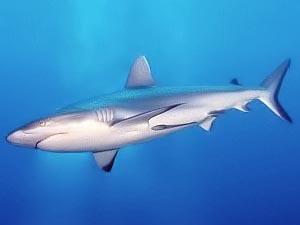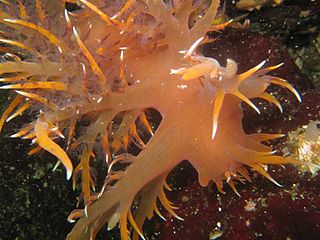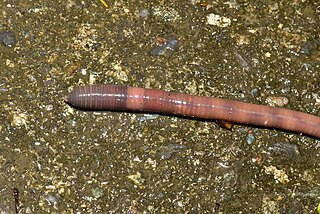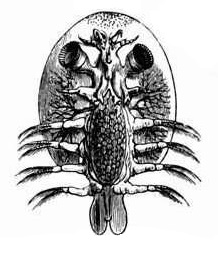
The openbill storks or openbills are two species of stork in the genus Anastomus. They are large wading birds characterized by large bills, the mandibles of which do not meet except at the tip. This feature develops only in the adults. Both species feed predominantly on molluscs. The roof of the upper bill is fringed with plate-like structures ("lamellae") in the African openbill, but these are absent in the Asian openbill.

The family Argulidae, whose members are commonly known as carp lice or fish lice, are parasitic crustaceans in the class Ichthyostraca. It is the only family in the monotypic subclass Branchiura and the order Arguloida, although a second family, Dipteropeltidae, has been proposed. Although they are thought to be primitive forms, they have no fossil record.

The Pentastomida are an enigmatic group of parasitic arthropods commonly known as tongue worms due to the resemblance of the species of the genus Linguatula to a vertebrate tongue; molecular studies point to them being highly-derived crustaceans.

Countershading, or Thayer's law, is a method of camouflage in which an animal's coloration is darker on the top or upper side and lighter on the underside of the body. This pattern is found in many species of mammals, reptiles, birds, fish, and insects, both in predators and in prey.

Frank Evers Beddard FRS FRSE was an English zoologist. He became a leading authority on annelids, including earthworms. He won the Linnean Medal in 1916 for his book on oligochaetes.
The Acanthodrilidae are an ancient and widely distributed family of earthworms which has native representatives in Australia, New Zealand, South Africa, South America, and North America. No native species are known from India nor Asia. The family possibly shows a pre-Pangaean distribution.

Serolis is a genus of isopod crustacean, containing the following species:

Dendronotus is a genus of sea slugs, nudibranchs, marine gastropod molluscs in the superfamily Tritonioidea.
Microchaetus rappi, the African Giant Earthworm, is a large earthworm in the family Microchaetidae, the largest of the segmented worms. It averages about 1.4 meters in length, but can reach a length of as much as 6.7 meters and can weigh over 1.5 kilograms.

Amynthas is a genus of earthworms in the family Megascolecidae. They are known as jumping worms, snake worms, or crazy worms because of their erratic thrashing behaviour when disturbed. The genus is native to East Asia, but they are invasive in many areas of the United States. They are a matter of concern in many states, as they disrupt the native forest ecology by affecting soil structure and chemistry.

Mussidia is a genus of snout moths described by Émile Louis Ragonot in 1888.

Animal Coloration, or in full Animal Coloration: An Account of the Principal Facts and Theories Relating to the Colours and Markings of Animals, is a book by the English zoologist Frank Evers Beddard, published by Swan Sonnenschein in 1892. It formed part of the ongoing debate amongst zoologists about the relevance of Charles Darwin's theory of natural selection to the observed appearance, structure, and behaviour of animals, and vice versa.

Argulus foliaceus, also known as the common fish louse, is a species of fish lice in the family Argulidae. It is "the most common and widespread native argulid in the Palaearctic" and "one of the most widespread crustacean ectoparasites of freshwater fish in the world", considering its distribution and range of hosts. It can cause the severe disease state argulosis in a wide variety of fish species. It is responsible for epizootic outbreaks that have led to the collapse of aquaculture operations. Fish lice are not related to lice, which are insects.

Satyu Yamaguti was a Japanese parasitologist, entomologist, and helminthologist. He was a specialist of mosquitoes and helminths such as digeneans, monogeneans, cestodes, acanthocephalans and nematodes. He also worked on the parasitic crustaceans Copepoda and Branchiura. Satyu Yamaguti wrote more than 60 scientific papers and, more importantly, several huge monographs which are still in use by scientists all over the world and were cited over 1,000 times each.
Microscolex is a genus of annelids belonging to the family Acanthodrilidae. The genus has cosmopolitan distribution.
Anuropus is a genus of isopods in the suborder Cymothoida. As of 2021, it is the only genus in the family Anuropidae.
Chonopeltis is a genus of fish lice in the subclass Branchiura. These crustaceans are ectoparasitic freshwater fish host. Species of this genus are exclusively found in rivers in Africa.

Pelobatrachus is a genus of frogs in the family Megophryidae. It was formerly synonymized with Megophrys until 2021, when it was revived as a distinct genus. They inhabit Southeast Asia, namely the Malay Peninsula, Sumatra, Borneo and the Philippines. Their common name is clay horned toads.

The carp louse Argulus coregoni is an obligate ectoparasitic branciuran species on fish. It occurs in China and Japan, and Scandinavia. Argulus coregoni can pose a threat to fish kept in fish farms.













